Market Overview
The Global Web 3.0 Market size is projected to reach USD 10.8 billion in 2025 and grow at a compound annual growth rate of 46.6% from there until 2034 to reach a value of USD 339.1 billion.
Web 3.0, also called the decentralized web, is the next generation of internet technology that focuses on giving users more control over their data and digital identity. Unlike Web 2.0, where major platforms control content and user data, Web 3.0 uses blockchain and peer-to-peer networks to create a more open and user-driven internet. This version of the web aims to reduce reliance on big tech companies and make the internet more democratic, secure, and transparent.
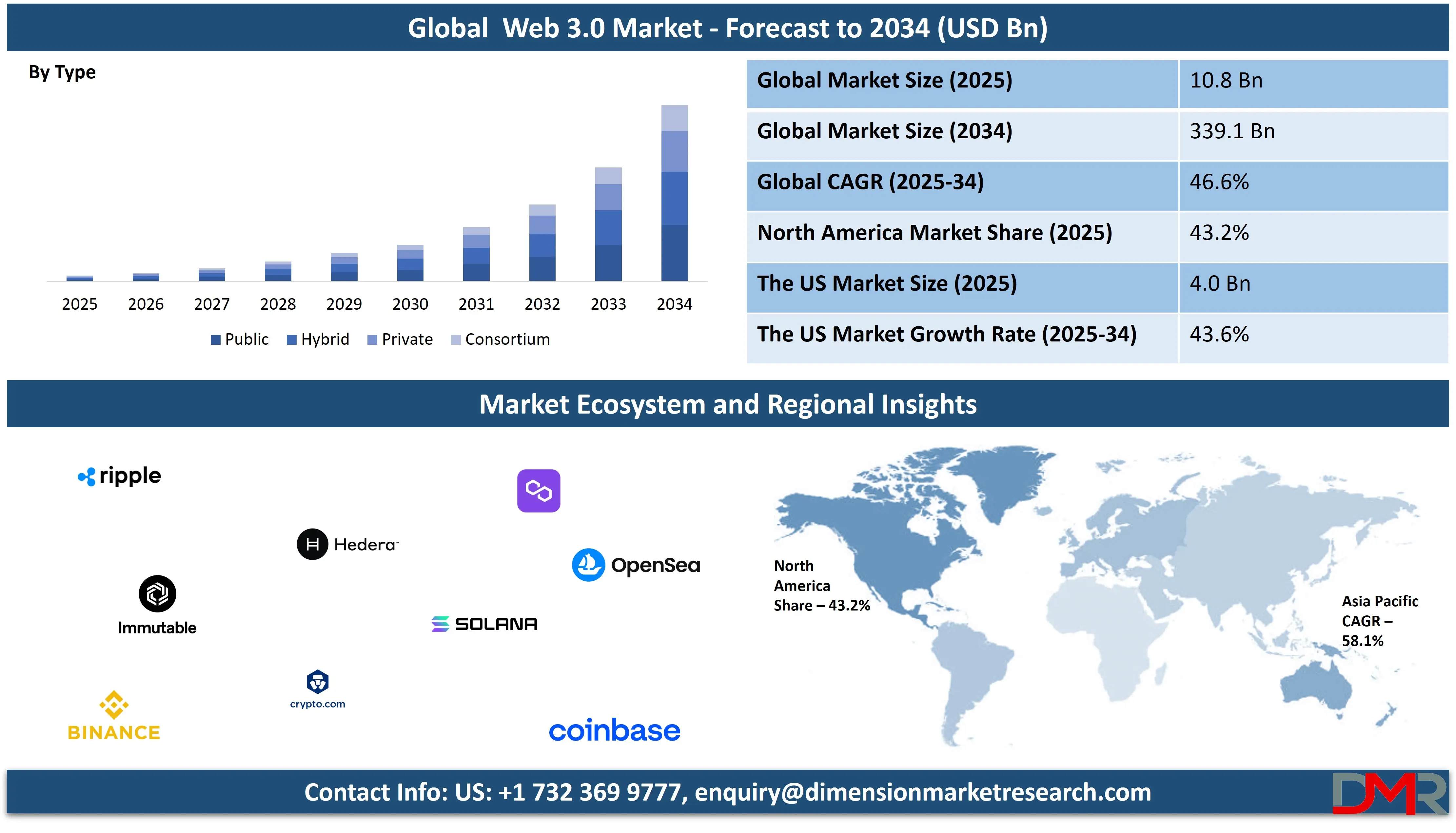
The demand for Web 3.0 has been growing steadily. As users become more aware of data privacy issues, they are seeking platforms where they own their personal data. At the same time, the rise of cryptocurrencies, smart contracts, and decentralized finance (DeFi) has shown the potential of blockchain in creating a trustless and permissionless internet.
Startups and tech giants are both exploring how to build Web 3.0 products such as decentralized social networks, marketplaces, and cloud services. This growth is also intertwined with advancements in Digital Adoption Platform technologies that simplify user onboarding, and Open-Source Intelligence tools that strengthen security and trust in decentralized ecosystems.
Several trends have emerged around Web 3.0 in recent years. One of the most important is the growing role of digital identity, where users can control their identity across platforms without revealing personal details. Another key trend is the shift from centralized applications to decentralized apps (dApps), which run on blockchain and are not controlled by a single entity.
The growth of the metaverse and immersive digital experiences has also supported the Web 3.0 movement, combining virtual spaces with user-owned digital assets and innovations such as the Virtual Mirror for interactive retail and e-commerce experiences.
Recent events have shaped the Web 3.0 space in powerful ways. Major companies and governments have started exploring or regulating blockchain technologies. Popular platforms like Reddit and Twitter have launched limited Web 3.0 features like digital wallets or token rewards. Meanwhile, crypto market shifts have influenced the pace of development, with some projects slowing down while others continue to innovate. Major hacks and scams have also raised concerns about safety and regulation in the space.
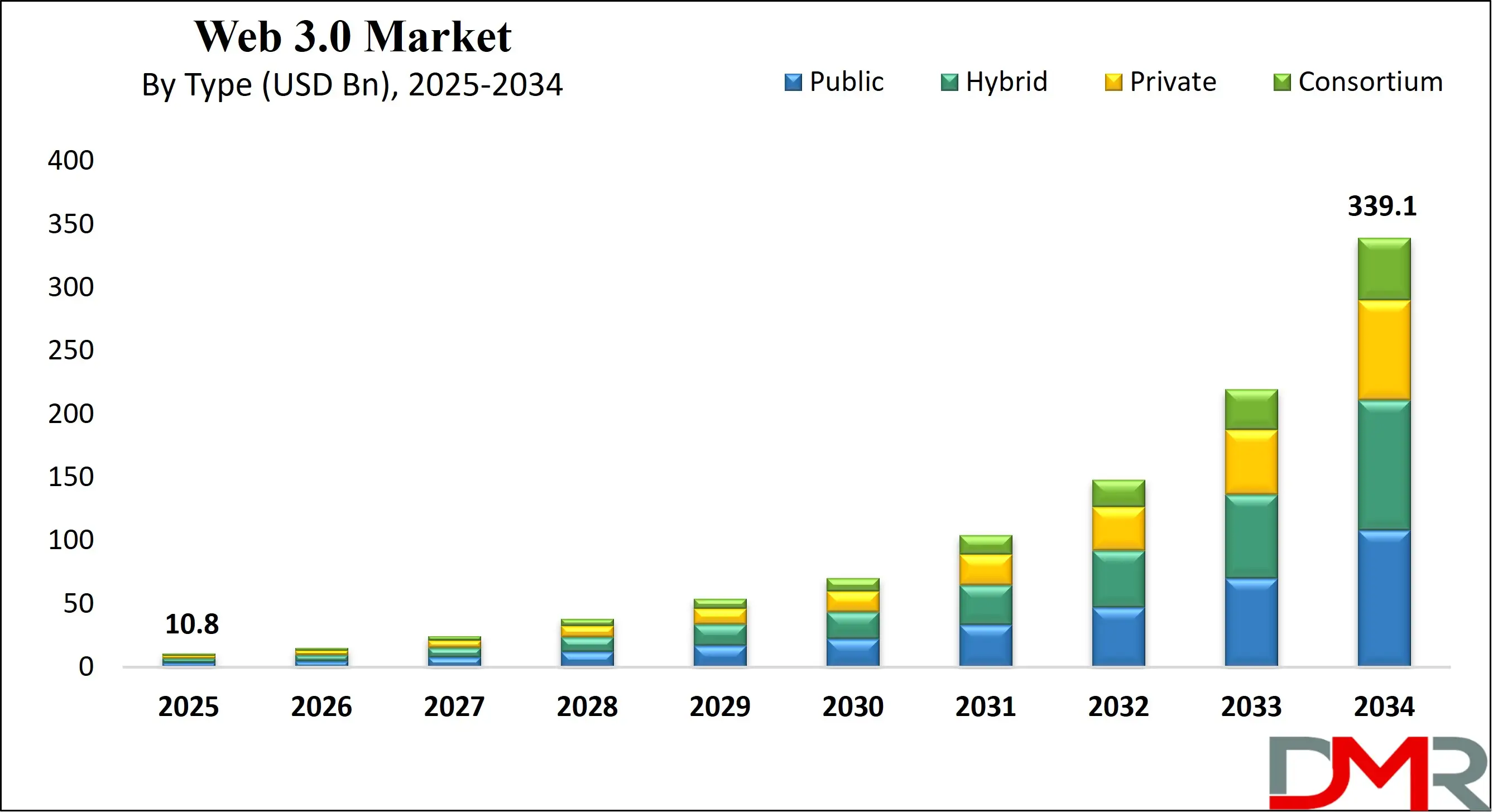
There are important insights to consider when looking at Web 3.0. First, adoption depends on making the technology easier for everyday users. Many people still find blockchain confusing or risky. Second, regulations will likely play a big role in shaping the future of decentralized platforms. Governments want to protect users but also encourage innovation. Finally, Web 3.0 is still in the early stages, and it may take years before it becomes mainstream.
The US Web 3.0 Market
The US Web 3.0 Market size is projected to reach USD 4.0 billion in 2025 at a compound annual growth rate of 43.6% over its forecast period.
The US plays a leading role in the Web 3.0 market as a hub for innovation, investment, and talent. Many of the world’s top blockchain developers, crypto startups, and Web 3.0 platforms are based in the US, supported by strong venture capital networks and advanced tech infrastructure.
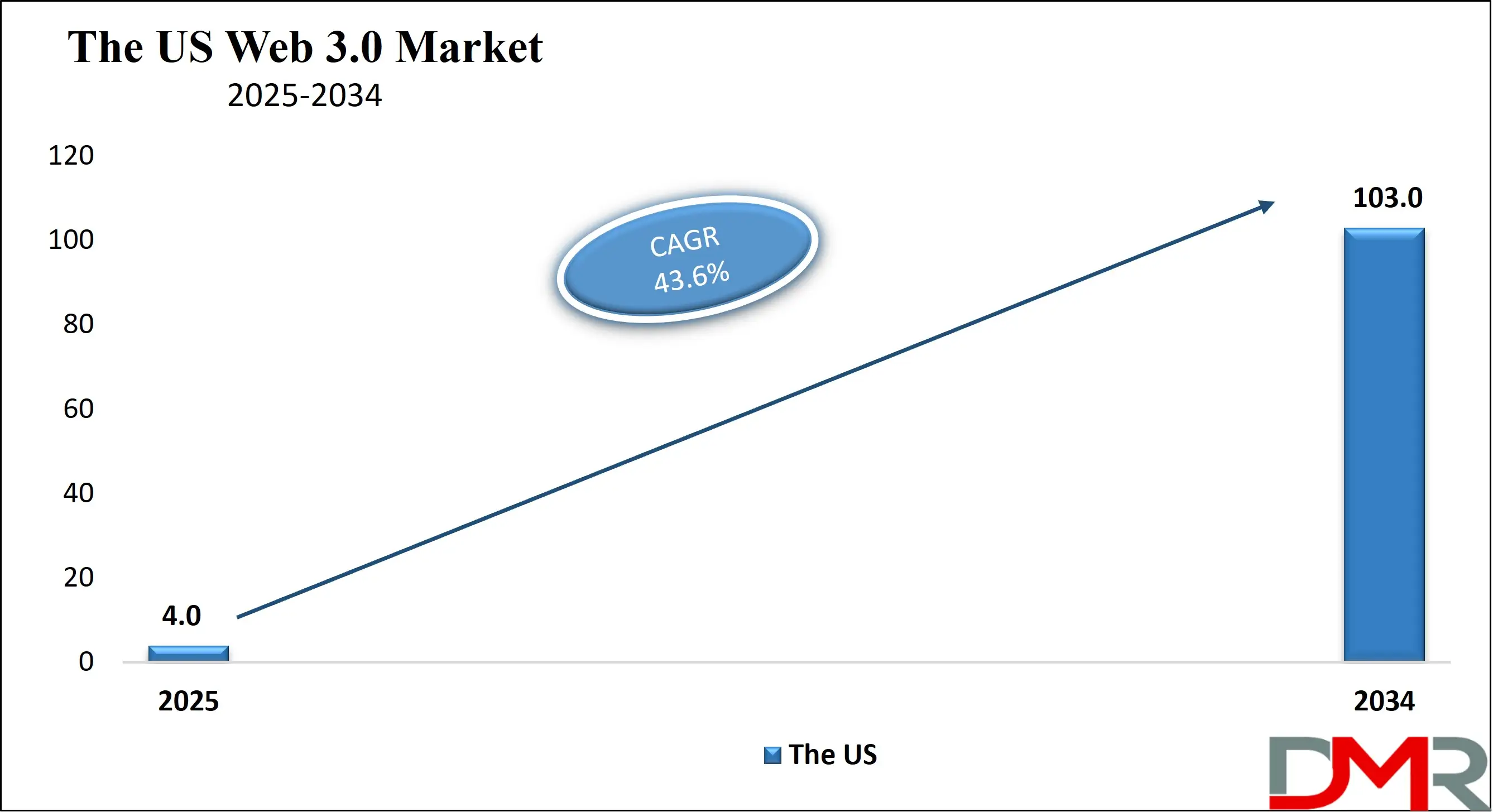
The country drives global conversations on standards, governance, and digital rights in decentralized ecosystems. However, regulatory uncertainty remains a challenge, with agencies exploring how to classify and manage crypto assets and decentralized applications. Despite this, the US continues to shape the direction of Web 3.0 through research, enterprise adoption, and community development. Its influence is key in setting trends and attracting global collaboration in the evolution of the decentralized internet.
Europe Web 3.0 Market
Europe Web 3.0 Market size is projected to reach USD 2.4 billion in 2025 at a compound annual growth rate of 42.9% over its forecast period.
Europe plays a strategic and influential role in the Web 3.0 market, especially in shaping regulation, digital rights, and ethical technology use. The region is focused on creating a safe, transparent, and privacy-focused digital ecosystem, supported by policies like the GDPR and the Markets in Crypto-Assets (MiCA) regulation.
European governments and institutions are actively investing in blockchain research, decentralized finance, and public-private collaborations. Several European countries have launched national strategies for blockchain adoption, driving innovation in areas such as identity, supply chains, and digital currencies. Europe also emphasizes open-source development and cross-border cooperation. While the region is not as fast-paced as the US in venture funding, its thoughtful regulatory approach and commitment to ethical tech make it a key player in Web 3.0’s global evolution.
Japan Web 3.0 Market
Japan Web 3.0 Market size is projected to reach USD 600 million in 2025 at a compound annual growth rate of 50.5% over its forecast period.
Japan plays an active role in the Web 3.0 market, driven by strong government interest and supportive policies. The government has shown commitment to fostering blockchain innovation through regulatory reforms and strategic planning. Japan’s large tech and financial companies are exploring decentralized applications, digital wallets, and blockchain-based identity systems.
The country’s strong presence in gaming, anime, and entertainment supports the growth of NFTs, virtual assets, and metaverse-related projects. Local governments and startups are also collaborating to build Web 3.0 hubs and developer communities. Japan maintains a structured and compliant crypto trading environment, which helps encourage wider adoption of decentralized technologies. With a balance of innovation, cultural strength, and policy support, Japan is steadily shaping its position in the global Web 3.0 ecosystem..
Web 3.0 Market: Key Takeaways
- Market Growth: The Web 3.0 Market size is expected to grow by USD 323.7 billion, at a CAGR of 46.6%, during the forecasted period of 2026 to 2034.
- By Type: The public segment is anticipated to get the majority share of the Web 3.0 Market in 2025.
- By Application: The cryptocurrency segment is expected to get the largest revenue share in 2025 in the Web 3.0 Market.
- Regional Insight: North America is expected to hold a 43.2% share of revenue in the Global Web 3.0 Market in 2025.
- Use Cases: Some of the use cases of Web 3.0 include digital identity ownership, decentralized social media, and more.
Web 3.0 Market: Use Cases
- Decentralized Finance (DeFi): Web 3.0 enables financial services without banks or intermediaries. Users can lend, borrow, trade, and earn interest directly through blockchain-based protocols. This creates open access to financial tools for anyone with an internet connection.
- Digital Identity Ownership: Instead of using usernames and passwords managed by third parties, users can own and manage their identity on the blockchain. This gives them full control over what data they share, improving privacy and security across platforms.
- Decentralized Social Media: Web 3.0 allows users to create and engage on social platforms that aren’t controlled by a single company. Content ownership, data privacy, and rewards for participation are key features of these new communities.
- Smart Contracts and Automation: Web 3.0 uses smart contracts—self-executing code—to automate agreements and tasks. This removes the need for middlemen in areas like real estate, insurance, or digital services, making processes faster and more transparent.
Stats & Facts
- According to Blanklesstimes, only 2% of game development companies are actively building or integrating Web3 features into their games, suggesting that adoption in the gaming industry remains at a very early stage despite growing market interest and user awareness.
- As per Blanklesstimes, a significant 76% of blockchain gamers believe that the ability to own digital assets is the most important benefit of Web3 gaming, highlighting how the concept of ownership is central to the appeal of decentralized game environments.
- Based on findings from Blanklesstimes, 40% of the Web3 community consists of millennials, showing that this age group is a leading force in driving interest, participation, and early adoption of blockchain-based internet experiences.
- Blanklesstimes also notes that the majority of current Web3 users are men, which points to a gender gap that exists in the early adoption phase and indicates a need for broader inclusivity efforts within the Web3 ecosystem.
- According to Blanklesstimes, in just the first half of 2023, Web3 games attracted nearly USD 800 million in investment, signaling strong financial backing and growing confidence in the potential of decentralized gaming experiences.
- As reported by Blanklesstimes, Web3 applications hit a record high in daily active users in July 2024, marking a peak in engagement and suggesting rising global interest in decentralized digital platforms and services.
- According to Blanklesstimes, only 20% of Gen-Z and 18% of Millennials have heard of Web3, reflecting a surprising awareness gap even among younger, tech-savvy generations often assumed to be at the forefront of digital innovation.
- As per Blanklesstimes, around 50% of people believe that Web3’s core qualities, such as decentralization and user control, will add real value to the future of the internet, indicating a growing belief in its long-term potential despite current challenges.
Market Dynamic
Driving Factors in the Web 3.0 Market
Rising Demand for Data Privacy and Ownership
One of the strongest growth drivers for the Web 3.0 market is the increasing global concern over data privacy and digital rights. Users are becoming more aware of how their personal information is collected, stored, and sold by traditional platforms. Web 3.0 offers a solution through decentralized systems that allow individuals to control their own data. With the use of blockchain, users can decide when and how their data is shared, and even monetize it if they choose.
This shift in user behavior is pushing developers to build more transparent and privacy-first platforms. As public trust in big tech companies continues to decline, interest in self-owned digital identities and decentralized services is likely to grow significantly.
Rapid Advancements in Blockchain Technology and Tools
The rapid improvement of blockchain infrastructure, tools, and developer ecosystems is fueling Web 3.0 innovation. Faster blockchains, better smart contract platforms, and scalable solutions like layer-2 networks are making it easier to build and run decentralized applications. These technical upgrades are solving earlier issues such as slow transaction speeds and high fees, which held back user adoption.
Open-source development is also encouraging collaboration and sharing of tools, helping new projects enter the market more quickly. Easier access to digital wallets, decentralized storage, and identity management tools is supporting both developers and users. As these technologies mature, the foundation for Web 3.0 becomes stronger, driving wider use across industries.
Restraints in the Web 3.0 Market
Lack of User Awareness and Complex User Experience
One of the major restraints of the Web 3.0 market is the limited awareness and understanding among general users. Many people are still unfamiliar with how blockchain works or how to interact with decentralized platforms. The user experience on most Web 3.0 applications is still far from seamless, often requiring technical knowledge to set up wallets, manage private keys, or use tokens.
This complexity creates a barrier for mass adoption, especially among non-tech-savvy users. Unlike Web 2.0 platforms that offer smooth interfaces and easy onboarding, Web 3.0 solutions often feel unfamiliar and complicated. Until interfaces become more intuitive and user education improves, adoption will remain limited beyond early adopters and developers.
Regulatory Uncertainty and Legal Challenges
Another key restraint in the Web 3.0 space is the unclear and constantly shifting regulatory environment. Many governments are still developing their policies regarding blockchain, digital currencies, and decentralized platforms.
This uncertainty creates hesitation among businesses and investors, who fear legal risks or sudden changes in compliance rules. Issues around taxation, data privacy laws, token classifications, and anti-money laundering requirements can vary widely across countries. In some cases, governments have even imposed bans or strict controls, slowing innovation. Without clear global standards or supportive regulations, Web 3.0 platforms face challenges in scaling across borders, limiting their growth and stability in the long run.
Opportunities in the Web 3.0 Market
Expansion into Emerging Markets and Digital Inclusion
Web 3.0 presents a major opportunity to drive digital inclusion in emerging markets where traditional financial systems and digital infrastructure are limited. Decentralized platforms can provide access to financial services, identity verification, and secure communication without the need for intermediaries.
With just a smartphone and internet access, users in remote areas can participate in global economies, access credit, or verify documents. This opens new markets for developers and startups aiming to create low-cost, scalable solutions. The trustless and transparent nature of blockchain can also reduce corruption and improve service delivery. As mobile usage grows in underserved regions, Web 3.0 tools can bridge digital gaps and unlock new user bases across the world.
Growth in Decentralized Applications and Creator Economy
The rise of decentralized applications (dApps) offers huge potential for reshaping how digital content, services, and communities are built and monetized. Web 3.0 enables creators—artists, musicians, educators, and developers—to earn directly from their work without relying on middlemen or platforms that take large commissions.
Blockchain-based systems support micro-payments, digital ownership through NFTs, and transparent revenue sharing, giving creators more power and income potential. Communities can also form around shared interests with built-in governance and reward systems. This decentralized creator economy is attracting both talent and investment, signaling strong future growth. As tools for building and launching dApps become more accessible, the number and diversity of Web 3.0 use cases will expand rapidly.
Trends in the Web 3.0 Market
Decentralized AI & Blockchain Integration
A major trend is the merging of decentralized AI with blockchain networks. This creates systems where AI models run on transparent, permissionless platforms—ensuring users keep control of their data during model training and usage. Use cases include predictive smart contracts and AI-powered dApps that run securely off-chain. This integration enhances privacy, accountability, and innovation, as decentralized AI can be verified on-chain, and smart contracts can adapt intelligently based on real-world data. As these systems evolve, Web 3.0 becomes more adaptive, automated, and trustworthy for diverse applications.
Tokenization of Real‑World Assets & DePIN Expansion
Another key trend is the ongoing tokenization of physical assets—like real estate, art, and commodities—allowing fractional ownership and 24/7 global trading. This shift boosts liquidity and democratizes investment in markets once reserved for the wealthy or institutional players. Alongside this, decentralized physical infrastructure networks (DePIN)—such as shared storage or telecom systems—are growing. They let individuals contribute resources and earn tokens in return. Together, these trends push Web 3.0 toward real-world integration, financial inclusion, and community-driven infrastructure.
Impact of Artificial Intelligence in Web 3.0 Market
Artificial Intelligence is playing a key role in shaping the evolution of the Web 3.0 market by enabling smarter, more personalized, and decentralized digital experiences. Web 3.0 aims to create a more intelligent and user-centric internet by combining blockchain, semantic web technologies, and AI.
AI enhances this by analyzing vast amounts of data to deliver tailored content, automate decision-making, and improve user interactions. In decentralized platforms, AI can help process and interpret user behavior, preferences, and intent to offer more relevant recommendations and services. This leads to a web experience that is not only secure and private but also intuitive and adaptive to individual needs.
Additionally, AI is strengthening the infrastructure of Web 3.0 through its ability to detect anomalies, improve cybersecurity, and ensure data integrity in decentralized applications. Smart contracts, a foundational element of Web 3.0, can be optimized using AI to predict outcomes, enhance efficiency, and automate complex logic. AI also supports decentralized finance (DeFi) by providing intelligent risk assessment, fraud detection, and market predictions. In digital identity management, AI plays a role in verifying identities and ensuring secure access without compromising user privacy.
Though challenges like ethical AI use, algorithm bias, and system transparency need careful handling, the combination of AI with Web 3.0 technologies is driving a new era of trust, automation, and innovation. Together, they are transforming the internet into a more open, efficient, and intelligent ecosystem, where users have greater control over their data and digital interactions.
Research Scope and Analysis
By Type Analysis
Public segment is expected to lead the Web 3.0 market in 2025 with a share of 31.8%, driven by growing interest in open-source platforms, decentralized applications, and blockchain-based public networks. This segment includes decentralized finance platforms, public blockchains, and community-driven protocols where anyone can participate without needing permission. As awareness about data ownership, transparency, and digital privacy increases, more users are choosing public platforms that promote trust and openness.
The rise of token economies, smart contracts, and community governance is also pushing the public segment forward. With developers and users across the globe supporting open innovation, the public type continues to build strong momentum. It is further strengthened by increasing use in applications like NFTs, digital identity, and peer-to-peer services, making it a major contributor to Web 3.0 growth.
Private segment, having significant growth over the forecast period, is gaining attention for its focus on security, compliance, and controlled access within Web 3.0 environments. Unlike public platforms, private networks are often used by businesses and institutions that require permissioned systems for sharing sensitive data or running internal operations.
These networks support enterprise blockchain applications, secure smart contracts, and private decentralized finance setups. Growth in this segment is driven by rising interest from industries like banking, supply chain, and healthcare, which are exploring ways to use blockchain without exposing data on open networks.
The private segment is also becoming attractive due to its ability to meet regulatory and data protection requirements while still leveraging key Web 3.0 features such as automation and transparency. As more enterprises adopt blockchain for secure and efficient digital transformation, the private type is expected to play a major role in shaping the future of Web 3.0.
By Application Analysis
Cryptocurrency segment is expected to lead the Web 3.0 market in 2025 with a share of 35.7%, playing a central role in shaping the decentralized internet. As the backbone of many blockchain ecosystems, cryptocurrencies support peer-to-peer transactions, reward systems, and digital asset ownership without the need for traditional banks.
This segment is gaining popularity for its ability to offer faster, borderless, and secure exchanges of value, aligning with the Web 3.0 goal of removing intermediaries. Users and developers alike are drawn to the transparency and control that crypto offers within decentralized applications and smart contracts. The growth of token economies, crypto wallets, and decentralized finance further fuels the segment’s expansion. With rising global awareness and improved accessibility, cryptocurrency continues to push the adoption of Web 3.0 technologies across industries and user communities.
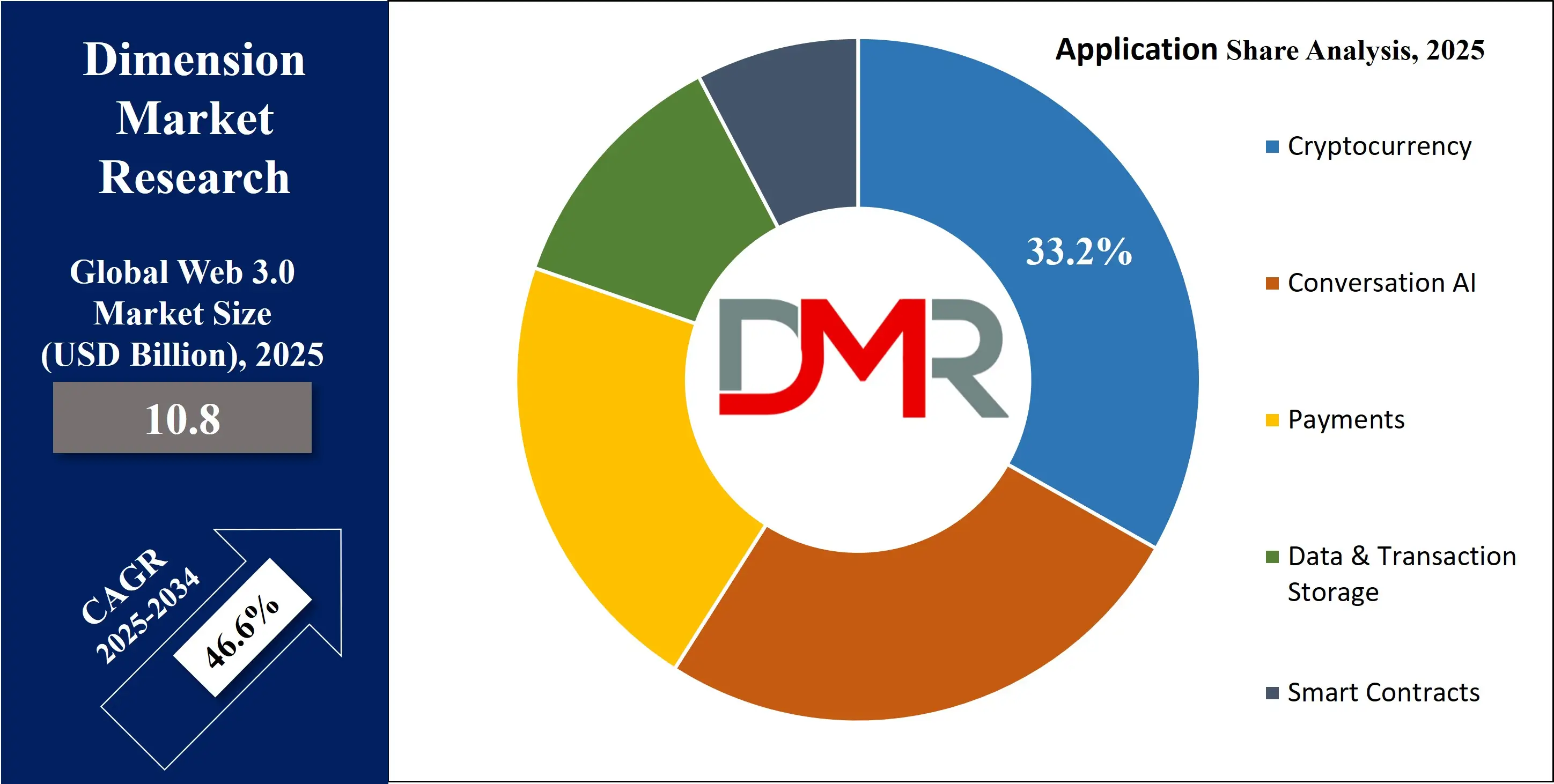
Payments segment, having significant growth over the forecast period, is emerging as a key driver in the adoption of Web 3.0 solutions. By using blockchain and smart contract technologies, Web 3.0 payments offer faster, cheaper, and more transparent alternatives to traditional systems.
These platforms reduce the need for intermediaries and help users send or receive funds across borders with minimal fees and delays. The ability to use stablecoins, tokens, or digital currencies in real time makes it more attractive for both consumers and businesses. Adoption is growing in areas like e-commerce, freelance work, and cross-border trade, where efficient payment methods are essential. With increased demand for decentralized financial tools, the payments application is set to strengthen its role in the Web 3.0 ecosystem.
By End Use Analysis
Retail & e-commerce segment is set to lead the Web 3.0 market in 2025 with a projected share of 40.2%, driven by increasing demand for personalized, secure, and decentralized shopping experiences. With blockchain technology, customers can verify product authenticity, track supply chains, and own digital receipts or rewards in the form of tokens. Web 3.0 also supports smart contracts that automate transactions, reducing errors and improving trust between buyers and sellers.
Brands are exploring decentralized marketplaces where users can trade goods or services directly without middlemen. Loyalty programs powered by crypto tokens and immersive shopping using metaverse platforms are also becoming popular. These features offer better transparency, more control over data, and a stronger customer connection. As consumer expectations evolve, retail and e-commerce businesses are adopting Web 3.0 tools to stay competitive and enhance user engagement across digital channels.
Media & entertainment segment, having significant growth over the forecast period, is playing a vital role in accelerating Web 3.0 adoption. With the rise of NFTs, content creators now have more control over their work and can earn directly from fans without relying on intermediaries. Decentralized platforms allow for fairer revenue sharing, copyright protection, and transparent content distribution.
Musicians, artists, and filmmakers are exploring token-based models to monetize digital assets and interact with global audiences. In gaming, Web 3.0 supports play-to-earn mechanics, virtual goods ownership, and blockchain-based rewards. The entertainment experience is becoming more immersive and interactive with support from smart contracts and metaverse environments. As creators seek better control and users demand richer experiences, this segment continues to drive strong Web 3.0 growth.
The Web 3.0 Market Report is segmented on the basis of the following:
By Type
- Public
- Private
- Hybrid
- Consortium
By Application
- Conversational AI
- Cryptocurrency
- Data & Transaction Storage
- Payments
- Smart Contracts
By End Use
- Retail & E-commerce
- BFSI
- Media & Entertainment
- Healthcare & Pharmaceuticals
- IT & Telecom
Regional Analysis
Leading Region in the Web 3.0 Market
North America is leading the Web 3.0 market in 2025 with an estimated share of 43.2%, driven by strong technological infrastructure, high digital adoption, and growing interest in decentralized platforms. The region’s progress is backed by active participation from tech startups, financial institutions, and blockchain developers who are building innovative solutions in areas like decentralized finance (DeFi), digital identity, and smart contracts. Supportive venture capital activity and a large base of early adopters further strengthen the region’s position.
In addition, the presence of major cloud providers and blockchain networks makes it easier to scale Web 3.0 projects. North America also benefits from active public discussions around digital privacy, data ownership, and internet freedom, which align closely with the core values of Web 3.0. While regulatory clarity remains a work in progress, many companies continue to experiment and grow. With ongoing development and strong digital capabilities, North America remains a key engine in driving the global Web 3.0 movement forward.
Fastest Growing Region in the Web 3.0 Market
Asia Pacific is showing significant growth in the Web 3.0 market over the forecast period, supported by rising digital adoption, strong developer communities, and government interest in blockchain innovation. Countries across the region are exploring use cases in decentralized finance (DeFi), NFTs, and smart contracts, while also encouraging investments in metaverse platforms and token-based economies.
Tech-savvy populations and widespread mobile usage are helping to speed up the adoption of decentralized applications. It is estimated that the region will see rapid expansion as both startups and established firms push forward with Web 3.0 technologies. Supportive policies and interest in digital currencies also add to the region’s growing influence.
By Region
North America
Europe
- Germany
- The U.K.
- France
- Italy
- Russia
- Spain
- Benelux
- Nordic
- Rest of Europe
Asia-Pacific
- China
- Japan
- South Korea
- India
- ANZ
- ASEAN
- Rest of Asia-Pacific
Latin America
- Brazil
- Mexico
- Argentina
- Colombia
- Rest of Latin America
Middle East & Africa
- Saudi Arabia
- UAE
- South Africa
- Israel
- Egypt
- Rest of MEA
Competitive Landscape
The Web 3.0 market is highly competitive and rapidly evolving, with many players working to shape the future of a decentralized internet. The landscape includes blockchain developers, infrastructure providers, decentralized app creators, and digital wallet platforms. Competition is strong as each aims to offer faster, safer, and more user-friendly tools and services. Innovation is key, with companies racing to build platforms that allow users to control their data, trade digital assets, or interact in virtual environments.
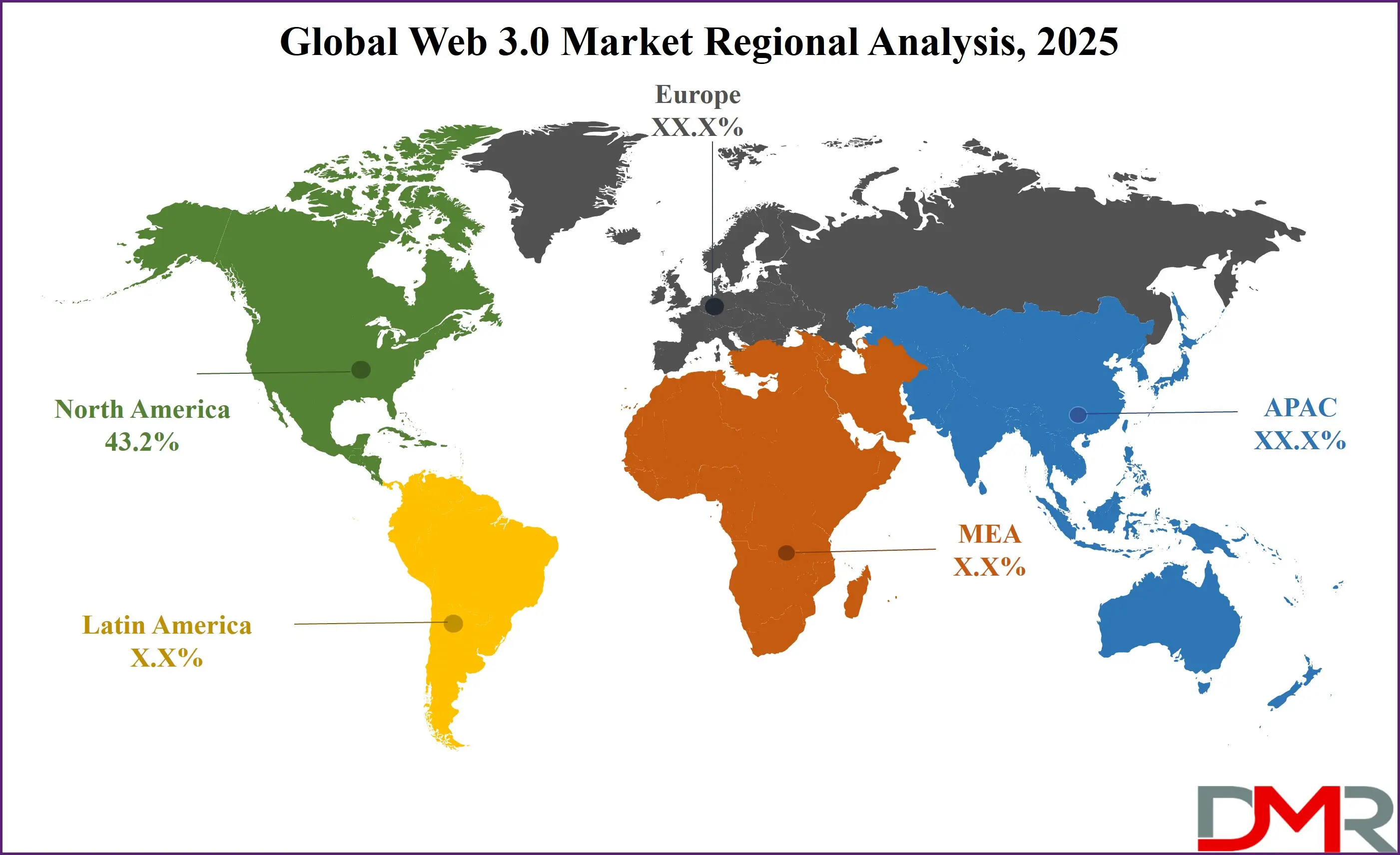
Some focus on privacy and security, while others work on improving scalability or lowering transaction costs. As more users explore Web 3.0, the pressure grows to create reliable systems that are easy to use. This dynamic environment continues to attract startups, developers, and investors worldwide.
Some of the prominent players in the global Web 3.0 are
- OpenSea
- Coinbase
- Binance
- Crypto.com
- Polygon
- Solana
- Immutable
- Hedera
- Gemini
- Ripple
- Chainalysis
- Consensys
- MetaMask
- Uniswap
- LayerZero
- Magic Eden
- FalconX
- Matter Labs (zkSync)
- Pagoda (NEAR tools)
- OKX
- Other Key Players
Recent Developments
- In April 2025, MetaEra launched its pre-A round of financing with a valuation of USD 40 million. The round is led by top-tier investment firm Fenbushi US, with strategic backing from Amber Group, Solomon Fund, FOMO Ventures, and Klickl Labs. Through this funding, MetaEra aims to accelerate service expansion, boost brand presence across Web 3.0 verticals, and introduce a new AI Agent business line, attracting further institutional strategic investors.
- In January 2025, WiSA Technologies, Inc. announced that it completed the acquisition of Datavault and ADIO’s IP and IT assets, advancing its commercialization strategy with a bold presence at CES 2025. The company will showcase its patented innovations in data valuation, monetization, AI-powered digital twins, acoustic mobile response, data-driven holograms, and immersive audio experiences. These cutting-edge technologies, showcased at key venues in Las Vegas, present a transformative vision of Web 3.0 that is poised to revolutionize how industries interact with data, entertainment, and immersive media.
- In September 2024, Ducati announced its entry into the Web 3.0 space through a partnership with NFT PRO™, a leading corporate white-label NFT platform, and Ripple, which will support the initiative via the fast, low-cost, and eco-friendly XRP Ledger (XRPL). This move highlights Ducati’s commitment to enhancing fan experiences through digital innovation. In the coming months, the brand will launch various Web 3.0 initiatives, including NFT collections, digital community spaces, and interactive opportunities aligned with trends in the cryptocurrency ecosystem.
- In August 2024, Tarento Technologies announced a strategic partnership with Dhiway, a leading enterprise Web 3.0 trust infrastructure provider. The collaboration, formalized through a Memorandum of Understanding (MoU), aims to develop scalable applications using the CORD Blockchain framework and Dhiway’s credentialing platform, MARK Studio. Together, they focus on designing and delivering advanced solutions that ensure data verifiability and continuous assurance. This partnership is set to revolutionize data pipeline management and data exchange processes, driving enhanced business efficiency and unlocking new opportunities across multiple use cases.
Frequently Asked Questions
The Global Web 3.0 Market is estimated to reach USD 5.0 billion in 2023, which is further expected to
reach USD 142.0 billion by 2032.
North America dominates the Global Web 3.0 Market with a share of 42.5% in 2023.
Some of the major key players in the Global Web 3.0 Market are Terra, Filecoin, IBM Corp, and many
others.
The market is growing at a CAGR of 45.1 percent over the forecasted period.